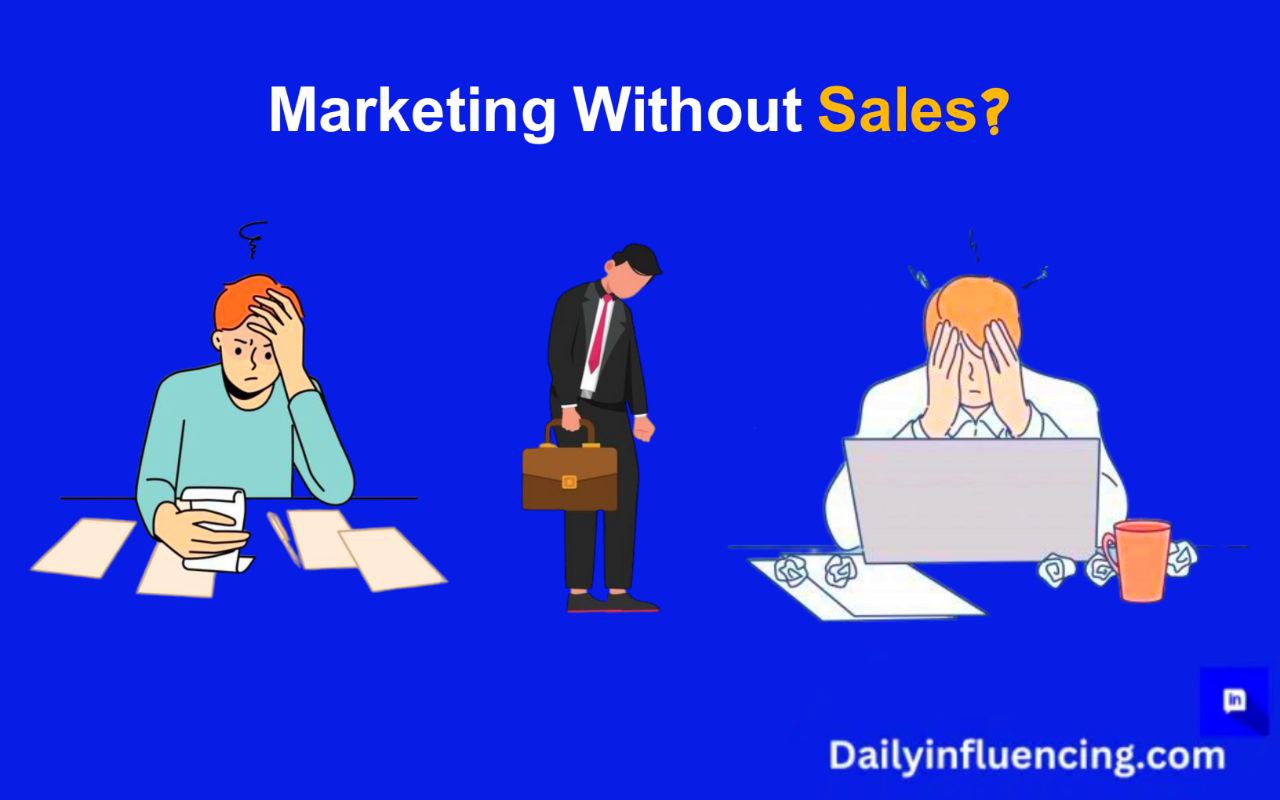
Wait a sec…Have you been Marketing without Sales? Get proven strategies to boost conversions & drive revenue growth.
Recent studies reveal that 68% of companies face challenges converting marketing leads into sales. Marketing teams drive creative campaigns and brand awareness, while sales teams propel revenue growth.
However, misalignment between these two functions can result in missed opportunities, wasted resources, and lost revenue.
In this article, we’ll explore proven strategies for aligning marketing efforts with sales objectives to boost conversions and fuel business growth.
Understanding the Cause of Marketing without Sales
A primary cause of marketing efforts failing to drive sales is the misalignment between marketing strategies and sales objectives. Marketing teams often operate in silos, focusing on brand building, audience engagement, and top-of-funnel activities without fully understanding the sales team’s desired outcomes.
This leads to campaigns generating high traffic or engagement but failing to attract convertible audiences.To address this disconnect, collaborative frameworks between marketing and sales departments are crucial. By establishing mutual objectives, marketing initiatives align with both branding and revenue generation pipelines.
Ineffective communication between the two teams further exacerbates the issue. Clear communication ensures both functions share a unified understanding of target customer profiles, market trends, and competitive landscapes. When sales teams are informed about ongoing marketing campaigns and messaging, they can streamline the conversion process.
For instance, if marketing emphasizes features while sales focuses on benefits, potential customers may become confused. Robust communication lines and regular check-ins bridge this gap, enabling both to present a coherent message resonating with their audience
Furthermore, lacking coherent measurement mechanisms perpetuates the cycle of marketing without sales.
Organizations often evaluate marketing efforts using metrics like website traffic, social media engagement, or lead volume, rather than conversion rates, customer acquisition costs, or long-term value. This approach occurs when marketing teams are not held accountable for their efforts’ impact on sales outcomes, causing them to focus on vanity metrics that don’t contribute to the bottom line.
To address this, marketers and sales leaders must implement integrated performance metrics that encompass both marketing effectiveness and sales success. This integrated approach provides a comprehensive understanding of marketing initiatives’ return on investment (ROI).
The Importance & Consequences of Alignment
Aligning marketing and sales is not just about improving internal processes; it’s about enhancing the customer experience and driving revenue growth. When these teams collaborate, they create a cohesive strategy that resonates with potential customers, driving long-term relationships and revenue growth.
Key Benefits of Alignment
Businesses can optimize resource allocation, accelerate time-to-market, and gain a competitive advantage. This harmonization also fosters enhanced customer experiences, increased revenue growth, improved communication, data-driven decision-making, and boosted employee satisfaction.
- 20-30% increase in revenue growth
- 25% increase in sales productivity
- 15% reduction in marketing waste
The Consequences of Misalignment
When both teams fail to align, the consequences can be severe. Misalignment leads to:
1. Wasted Resources
- Inefficient marketing spend
- Ineffective efforts
- Duplicate or conflicting campaigns
2. Lost Opportunities
- Missed sales targets
- Unrealized revenue potential
3. Damaged Customer Experience
- Conflicting messaging
- Poorly timed interactions
4. Decreased Productivity
- Teams working in silos
- Redundant or unnecessary tasks
5. Reduced Trust
- Both Teams doubting each other’s abilities
- Lack of transparency and communication
- Eroding collaboration and teamwork
6. Stunted Growth
- Limited scalability
- Reduced competitiveness
- Missed market opportunities
Proven Strategies for Fixing the Gap
To address the gap can adopt several proven strategies. These methods will not only foster collaboration but also create a seamless experience for customers, resulting in improved conversion rates. Below are detailed strategies designed for effective integration.
Establish Shared Goals
One of the most effective ways to ensure alignment is to establish shared goals. This process begins with defining key performance indicators (KPIs) that both teams can agree upon. For example, rather than focusing solely on marketing-generated leads or sales revenue, a joint goal could be the conversion rate of leads generated through marketing campaigns.
Improve Sales and Marketing Team Communication
Regular communication is pivotal for keeping both aligned. To achieve this, schedule weekly or bi-weekly meetings where both teams discuss ongoing campaigns, lead quality, and feedback. These meetings create an open dialogue where teams voice concerns, share insights, and update each other on new products or market developments.
Additionally, teams can implement collaborative tools like Slack, Microsoft Teams, Asana, or Trello to facilitate real-time communication and information sharing. By using these tools, teams ensure constant updates and seamless coordination.
Create a Unified Customer Persona
Understanding the target audience is critical for both. Creating a unified customer persona is a strategic move that allows both teams to speak the same language. This persona should be based on comprehensive research, including demographic, psychographic, and behavioral data.
Implement Lead Scoring
Lead scoring is an essential practice that allows marketing and sales to prioritize leads effectively. By assigning scores based on various criteria — such as engagement with marketing materials, demographic fit, and behavior on the website — both teams can identify high-value leads and pursue them quickly.
Train Sales People on Marketing Initiatives
Equip sales employees with knowledge about current marketing initiatives to sell more effectively. Conduct regular training sessions on new campaigns, product updates, and relevant information.
When professionals understand marketing goals and context, they tailor pitches to align with campaigns. This enhances customer experiences and conversion rates.
Measuring Marketing Sales Progress: Are You on Track?
As you work to bridge the gap, it’s essential to track your progress.
7 signs You’re on the Right Track
1. Unified Goals: Both teams share common objectives.
2. Improved Lead Quality: Higher-quality leads convert at a higher rate.
3. Enhanced Customer Experience: Personalized engagement across all touchpoints.
4. Reduced Sales Cycles: Faster conversion times from lead generation to sale.
5. Increased Sales-Ready Leads: More marketing-qualified leads convert to sales-qualified leads.
6. Accurate Sales Forecasting: Reliable revenue predictions.
7. Measurable ROI: Marketing investments yield tangible returns.
Conclusion
In conclusion, bridging the gap is vital for driving business growth. By implementing key strategies – establishing shared goals, enhancing communication, creating unified customer personas, implementing lead scoring, and developing nurturing strategies – organizations can cultivate a collaborative culture that boosts conversion rates.
Furthermore, training sales teams on marketing initiatives and leveraging analytics strengthens this partnership, yielding better results.Ultimately, aligning the both creates a seamless customer experience, a critical competitive advantage in today’s market.
As we reflect on these alignment strategies, it becomes evident that both team must work together to achieve sustainable success. Therefore, organizations must recognize the importance of this partnership and take proactive steps toward integration.
In the end, harmonizing marketing and sales enables businesses to build a robust framework for long-term success, driving growth, revenue, and customer satisfaction.




